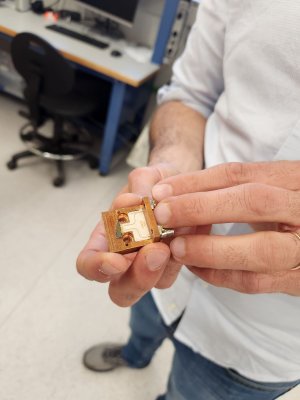Researchers from the Hebrew University of Jerusalem in Israel have made a recent discovery that could change the face of spintronics research.
A spintronics device developed by Professor Capua's lab
They discovered that the most important equation used to describe magnetization dynamics, namely the Landau-Lifshitz-Gilbert (LLG) equation, also applies to the optical domain. Consequently, they found that the helicity-dependent optical control of the magnetization state emerges naturally from their calculations. This is a very surprising result since the LLG equation was considered to describe much slower dynamics and it was not expected to yield a meaningful outcome also at the optical limit.
Assistant Prof. Amir Capua heads the Spintronics Lab at the Institute of Applied Physics and Electrical Engineering at the Hebrew University of Jerusalem. Prof. Capua has an impressive background in both industry (IBM, Intel) and academia, with experience in the fields of semiconductor laser physics, quantum optics, spintronics and more. Now he heads a team that explores spin transport phenomena in atomically engineered solid state devices for novel sensing, processing, and memory applications.
Working closely with a member of his team, he reached this groundbreaking discovery. This team member’s name is Benjamin Assouline, a bright Ph.D. candidate at the Spintronics Lab, Institute of Applied Physics and Electrical Engineering at the Hebrew University of Jerusalem, Israel.
Prof. Capua (left) and Benjamin Assouline (right) in the lab
The new discovery has relevant applications in optical magnetic recording, namely in optically-controlled MRAM technology. Manipulation of the magnetization order parameter on optical timescales is key for ultrafast spintronics, which allows for faster, energy-efficient optically-controlled MRAM technology.
The optical magnetic recording application has been considered for several decades but has yet matured. The optical powers required for the application were too strong to be technologically relevant. Having a better understanding opens new opportunities. The results also provided a much better understanding of the interaction between spins and optical fields. The research triggered new ideas on how to design and engineer the materials for such an optically-controlled MRAM technology.
The team, identifying the potential of their recent discovery, already applied for several related patents. The team’s work is currently under review for publication. A preprint is available at: arXiv:2306.04617.


"...that could change the…
"...that could change the face of spintronics" That's pretty far fetched. Particularly for a theoretical paper that doesn't even cite many of the experimental works where helicity dependent optical torques have been observed...
Pretty interesting, looking…
Pretty interesting, looking forward to read the full article.
Dear Jd, Thank you for the…
Dear Jd,
Thank you for the note, the arXiv is a preprint of course, and will be soon updated with a new version.
Thanks for pointing that out.